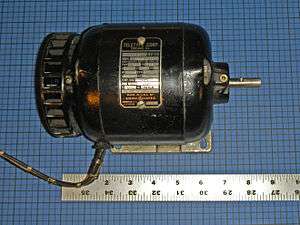Synchronous motor
A synchronous electric motor is an AC motor in which, at steady state,[1] the rotation of the shaft is synchronized with the frequency of the supply current; the rotation period is exactly equal to an integral number of AC cycles. Synchronous motors contain multiphase AC electromagnets on the stator of the motor that create a magnetic field which rotates in time with the oscillations of the line current. The rotor with permanent magnets or electromagnets turns in step with the stator field at the same rate and as a result, provides the second synchronized rotating magnet field of any AC motor. A synchronous motor is termed doubly fed if it is supplied with independently excited multiphase AC electromagnets on both the rotor and stator.
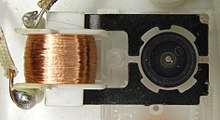
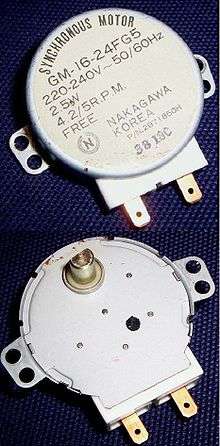
The synchronous motor and induction motor are the most widely used types of AC motor. The difference between the two types is that the synchronous motor rotates at a rate locked to the line frequency since it does not rely on current induction to produce the rotor's magnetic field. By contrast, the induction motor requires slip: the rotor must rotate slightly slower than the AC alternations in order to induce current in the rotor winding. Small synchronous motors are used in timing applications such as in synchronous clocks, timers in appliances, tape recorders and precision servomechanisms in which the motor must operate at a precise speed; speed accuracy is that of the power line frequency, which is carefully controlled in large interconnected grid systems.
Synchronous motors are available in self-excited sub-fractional horsepower sizes[2] to high power industrial sizes.[1] In the fractional horsepower range, most synchronous motors are used where precise constant speed is required. These machines are commonly used in analog electric clocks, timers and other devices where correct time is required. In higher power industrial sizes, the synchronous motor provides two important functions. First, it is a highly efficient means of converting AC energy to work. Second, it can operate at leading or unity power factor and thereby provide power-factor correction.
Type
Synchronous motors fall under the more general category of synchronous machines which also includes the synchronous generator. Generator action will be observed if the field poles are "driven ahead of the resultant air-gap flux by the forward motion of the prime mover". Motor action will be observed if the field poles are "dragged behind the resultant air-gap flux by the retarding torque of a shaft load".[1]
There are two major types of synchronous motors depending on how the rotor is magnetized: non-excited and direct-current excited.[3]
Non-excited motors
In non-excited motors, the rotor is made of steel. At synchronous speed it rotates in step with the rotating magnetic field of the stator, so it has an almost-constant magnetic field through it. The external stator field magnetizes the rotor, inducing the magnetic poles needed to turn it. The rotor is made of a high-retentivity steel such as cobalt steel. These are manufactured in permanent magnet, reluctance and hysteresis designs:[4]
Reluctance motors
These have a rotor consisting of a solid steel casting with projecting (salient) toothed poles. Typically there are fewer rotor than stator poles to minimize torque ripple and to prevent the poles from all aligning simultaneously—a position that cannot generate torque.[2][5] The size of the air gap in the magnetic circuit and thus the reluctance is minimum when the poles are aligned with the (rotating) magnetic field of the stator, and increases with the angle between them. This creates a torque pulling the rotor into alignment with the nearest pole of the stator field. Thus at synchronous speed the rotor is "locked" to the rotating stator field. This cannot start the motor, so the rotor poles usually have squirrel-cage windings embedded in them, to provide torque below synchronous speed. The machine starts as an induction motor until it approaches synchronous speed, when the rotor "pulls in" and locks to the rotating stator field.[6]
Reluctance motor designs have ratings that range from fractional horsepower (a few watts) to about 22 kW. Very small reluctance motors have low torque, and are generally used for instrumentation applications. Moderate torque, multi-horsepower motors use squirrel cage construction with toothed rotors. When used with an adjustable frequency power supply, all motors in the drive system can be controlled at exactly the same speed. The power supply frequency determines motor operating speed.
Hysteresis motors
These have a solid smooth cylindrical rotor, cast of a high coercivity magnetically "hard" cobalt steel.[5] This material has a wide hysteresis loop (high coercivity), meaning once it is magnetized in a given direction, it requires a large reverse magnetic field to reverse the magnetization. The rotating stator field causes each small volume of the rotor to experience a reversing magnetic field. Because of hysteresis the phase of the magnetization lags behind the phase of the applied field. The result of this is that the axis of the magnetic field induced in the rotor lags behind the axis of the stator field by a constant angle δ, producing a torque as the rotor tries to "catch up" with the stator field. As long as the rotor is below synchronous speed, each particle of the rotor experiences a reversing magnetic field at the "slip" frequency which drives it around its hysteresis loop, causing the rotor field to lag and create torque. There is a 2-pole low reluctance bar structure in the rotor.[5] As the rotor approaches synchronous speed and slip goes to zero, this magnetizes and aligns with the stator field, causing the rotor to "lock" to the rotating stator field.
A major advantage of the hysteresis motor is that since the lag angle δ is independent of speed, it develops constant torque from startup to synchronous speed. Therefore, it is self-starting and doesn't need an induction winding to start it, although many designs do have a squirrel-cage conductive winding structure embedded in the rotor to provide extra torque at start-up.
Hysteresis motors are manufactured in sub-fractional horsepower ratings, primarily as servomotors and timing motors. More expensive than the reluctance type, hysteresis motors are used where precise constant speed is required.
Permanent-magnet motors
A permanent-magnet synchronous motor (PMSM) uses permanent magnets embedded in the steel rotor to create a constant magnetic field. The stator carries windings connected to an AC supply to produce a rotating magnetic field (as in an asynchronous motor). At synchronous speed the rotor poles lock to the rotating magnetic field. Permanent magnet synchronous motors are similar to brushless DC motors. Neodymium magnets are the most commonly used magnets in these motors.
Permanent magnet motors have been used as gearless elevator motors since 2000.[7]
Most PMSMs require a variable-frequency drive to start.[8][9][10][11][12] However, some incorporate a squirrel cage in the rotor for starting — these are known as line-start or self-starting PMSMs.[13] These are typically used as higher-efficiency replacements for induction motors (owing to the lack of slip), but need to be specified carefully for the application to ensure that synchronous speed is reached and that the system can withstand the torque ripple during starting.
DC-excited motors
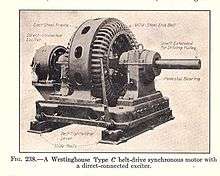
Usually made in larger sizes (larger than about 1 horsepower or 1 kilowatt) these motors require direct current (DC) supplied to the rotor for excitation. This is most straightforwardly supplied through slip rings, but a brushless AC induction and rectifier arrangement may also be used.[14] The direct current may be supplied from a separate DC source or from a DC generator directly connected to the motor shaft.
Control techniques
A permanent magnet synchronous motor and reluctance motor requires a control system for operating (VFD or servo drive).
There are a large number of control methods for PMSM, which is selected depending on the construction of the electric motor and the scope.
Control methods can be divided into:[15]
Sinusoidal
Trapezoidal
- Open loop
- Closed loop (with and without Hall sensor)
Synchronous speed
The synchronous speed of a synchronous motor is given:[16]
in RPM, by:
and in rad·s−1, by:
where:
- is the frequency of the AC supply current in Hz,
- is the number of poles.
- is the number of pole pairs (rarely, planes of commutation), .
Examples
A single-phase, 4-pole (2-pole-pair) synchronous motor is operating at an AC supply frequency of 50 Hz. The number of pole-pairs is 2, so the synchronous speed is:
A three-phase, 12-pole (6-pole-pair) synchronous motor is operating at an AC supply frequency of 60 Hz. The number of pole-pairs is 6, so the synchronous speed is:
Construction
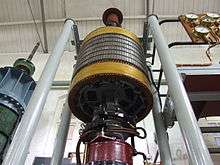
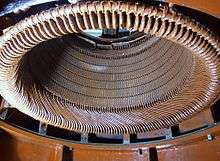
The principal components of a synchronous motor are the stator and the rotor.[17] The stator of synchronous motor and stator of induction motor are similar in construction.[18] With the wound-rotor synchronous doubly fed electric machine as the exception, the stator frame contains wrapper plate.[19] Circumferential ribs and keybars are attached to the wrapper plate.[19] To carry the weight of the machine, frame mounts and footings are required.[19] When the field winding is excited by DC excitation, brushes and slip rings are required to connect to the excitation supply.[20] The field winding can also be excited by a brushless exciter.[21] Cylindrical, round rotors, (also known as non salient pole rotor) are used for up to six poles. In some machines or when a large number of poles are needed, a salient pole rotor is used.[22][23] The construction of synchronous motor is similar to that of a synchronous alternator.[24]
Operation
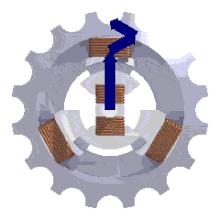
The operation of a synchronous motor is due to the interaction of the magnetic fields of the stator and the rotor. Its stator winding, which consists of a 3 phase winding, is provided with a 3 phase supply, and the rotor is provided with a DC supply. The 3 phase stator winding carrying 3 phase currents produces 3 phase rotating magnetic flux (and therefore a rotating magnetic field). The rotor locks in with the rotating magnetic field and rotates along with it. Once the rotor field locks in with the rotating magnetic field, the motor is said to be in synchronization. A single-phase (or two-phase derived from single phase) stator winding is possible, but in this case the direction of rotation is not defined and the machine may start in either direction unless prevented from doing so by the starting arrangements.[25]
Once the motor is in operation, the speed of the motor is dependent only on the supply frequency. When the motor load is increased beyond the breakdown load, the motor falls out of synchronization and the field winding no longer follows the rotating magnetic field. Since the motor cannot produce (synchronous) torque if it falls out of synchronization, practical synchronous motors have a partial or complete squirrel-cage damper (amortisseur) winding to stabilize operation and facilitate starting. Because this winding is smaller than that of an equivalent induction motor and can overheat on long operation, and because large slip-frequency voltages are induced in the rotor excitation winding, synchronous motor protection devices sense this condition and interrupt the power supply (out of step protection).[25]
Starting methods
Above a certain size, synchronous motors are not self-starting motors. This property is due to the inertia of the rotor; it cannot instantly follow the rotation of the magnetic field of the stator. Since a synchronous motor produces no inherent average torque at standstill, it cannot accelerate to synchronous speed without some supplemental mechanism.[2]
Large motors operating on commercial power frequency include a squirrel-cage induction winding which provides sufficient torque for acceleration and which also serves to damp oscillations in motor speed in operation.[2] Once the rotor nears the synchronous speed, the field winding is excited, and the motor pulls into synchronization. Very large motor systems may include a "pony" motor that accelerates the unloaded synchronous machine before load is applied.[26][27] Motors that are electronically controlled can be accelerated from zero speed by changing the frequency of the stator current.[28]
Very small synchronous motors are commonly used in line-powered electric mechanical clocks or timers that use the power line frequency to run the gear mechanism at the correct speed. Such small synchronous motors are able to start without assistance if the moment of inertia of the rotor and its mechanical load is sufficiently small [because the motor] will be accelerated from slip speed up to synchronous speed during an accelerating half cycle of the reluctance torque."[2] Single-phase synchronous motors such as in electric wall clocks can freely rotate in either direction unlike a shaded-pole type. See Shaded-pole synchronous motor for how consistent starting direction is obtained.
The operational economics is an important parameter to address different motor starting methods.[29] Accordingly, the excitation of the rotor is a possible way to solve the motor starting issue.[30] In additions, modern proposed starting methods for large synchronous machines includes repetitive polarity inversion of the rotor poles during startup.[31]
Applications, special properties, and advantages
Use as synchronous condenser
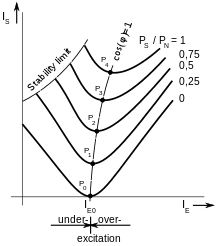
By varying the excitation of a synchronous motor, it can be made to operate at lagging, leading and unity power factor. Excitation at which the power factor is unity is termed normal excitation voltage.[32] The magnitude of current at this excitation is minimum.[32] Excitation voltage more than normal excitation is called over excitation voltage, excitation voltage less than normal excitation is called under excitation.[32] When the motor is over excited, the back emf will be greater than the motor terminal voltage. This causes a demagnetizing effect due to armature reaction.[33]
The V curve of a synchronous machine shows armature current as a function of field current. With increasing field current armature current at first decreases, then reaches a minimum, then increases. The minimum point is also the point at which power factor is unity.[34]
This ability to selectively control power factor can be exploited for power factor correction of the power system to which the motor is connected. Since most power systems of any significant size have a net lagging power factor, the presence of overexcited synchronous motors moves the system's net power factor closer to unity, improving efficiency. Such power-factor correction is usually a side effect of motors already present in the system to provide mechanical work, although motors can be run without mechanical load simply to provide power-factor correction. In large industrial plants such as factories the interaction between synchronous motors and other, lagging, loads may be an explicit consideration in the plant's electrical design.
Steady state stability limit
where,
- is the torque
- is the torque angle
- is the maximum torque
here,
When load is applied, torque angle increases. When = 90° the torque will be maximum. If load is applied further then the motor will lose its synchronism, since motor torque will be less than load torque.[35][36] The maximum load torque that can be applied to a motor without losing its synchronism is called steady state stability limit of a synchronous motor.[35]
Other
Synchronous motors are especially useful in applications requiring precise speed and/or position control.
- Speed is independent of the load over the operating range of the motor.
- Speed and position may be accurately controlled using open loop controls; e.g., stepper motors.
- Low-power applications include positioning machines, where high precision is required, and robot actuators.
- They will hold their position when a DC current is applied to both the stator and the rotor windings.
- A clock driven by a synchronous motor is in principle as accurate as the line frequency of its power source. (Although small frequency drifts will occur over any given several hours, grid operators actively adjust line frequency in later periods to compensate, thereby keeping motor-driven clocks accurate; see Utility frequency#Stability.)
- Record player turntables
- Increased efficiency in low-speed applications (e.g., ball mills).
Subtypes
- AC Polyphase synchronous motors
- Stepper motor (may be synchronous or not)
- Synchronous brushless wound-rotor doubly-fed electric machine.
See also
- Clock drive
- Doubly fed electric machine
- Short circuit ratio
References
- Fitzgerald, A. E.; Charles Kingsley Jr.; Alexander Kusko (1972). "Chapter 6, Synchronous machines, steady state". Electric Machinery, 3rd Ed. USA: McGraw-Hill. pp. 283–330. Library of Congress Catalog No. 70-137126.
- Fitzgerald, A. E.; Charles Kingsley Jr.; Alexander Kusko (1971). "Chapter 11, section 11.2 Starting and Running Performance of Single-phase Induction and Synchronous Motors, Self-starting Reluctance Motors". Electric Machinery, 3rd Ed. USA: McGraw-Hill. pp. 536–538. Library of Congress Catalog No. 70-137126.
- James G Stallcup, Stallcup's Generator, Transformer, Motor and Compressor, page 15-13, Jones & Bartlett, 2012 ISBN 1-4496-9519-1.
- William Yeadon (ed.), Handbook of Small Electric Motors, McGraw-Hill 2001 ISBN 0-07-072332-X, Chapter 12 "Synchronous Machines"
- Gottlieb, Irving M. (1997). Practical electric motor handbook, 2nd Ed. USA: Newnes. pp. 73–76. ISBN 978-0-7506-3638-4.
- Michael A. Laughton (2003), "19.2.5 Reluctance motors", Electrical Engineer's Reference Book, Newnes, p. 19/8, ISBN 978-0-7506-4637-6
- Mehri, Darius (18 September 2000). "Belts lift performance". DesignNews.com. Archived from the original on 29 June 2013. Retrieved 10 May 2016.
- R. Islam; I. Husain; A. Fardoun; K. McLaughlin. "Permanent-Magnet Synchronous Motor Magnet Designs With Skewing for Torque Ripple and Cogging Torque Reduction". Industry Applications, IEEE Transactions on. 2009. doi: 10.1109/TIA.2008.2009653
- Ki-Chan Kim; Seung-Bin Lim; Dae-Hyun Koo; Ju Lee. The Shape Design of Permanent Magnet for Permanent Magnet Synchronous Motor Considering Partial Demagnetization". Magnetics, IEEE Transactions on. 2006. doi: 10.1109/TMAG.2006.879077
- P. Pillay; R. Krishnan. "Application characteristics of permanent magnet synchronous and brushless DC motors for servo drives". Industry Applications, IEEE Transactions on. 1991. doi: 10.1109/28.90357 quote: "The permanent magnet synchronous motor (PMSM) and the brushless DC motor (BDCM) have many similarities; they both have permanent magnets on the rotor and require alternating stator currents to produce constant torque."
- Y. Honda; T. Nakamura; T. Higaki; Y. Takeda. "Motor design considerations and test results of an interior permanent magnet synchronous motor for electric vehicles". Industry Applications Conference, 1997. Thirty-Second IAS Annual Meeting, IAS '97., Conference Record of the 1997 IEEE. 1997. doi: 10.1109/IAS.1997.643011
- M.A. Rahman; Ping Zhou. "Analysis of brushless permanent magnet synchronous motors". Industrial Electronics, IEEE Transactions on. 1996. doi: 10.1109/41.491349
- Hassanpour Isfahani, Arash; Vaez-Zadeh, Sadegh (Nov 2009). "Line start permanent magnet synchronous motors: Challenges and opportunities". Energy. 34 (11): 1755–1763. doi:10.1016/j.energy.2009.04.022.
- H.E. Jordan, Energy-Efficient Electric Motors and Their Applications, page 104, Springer, 1994 ISBN 0-306-44698-7
- "Permanent Magnet Synchronous Motor". en.engineering-solutions.ru. Retrieved 2019-07-02.
- "Motor speed". Electrician's toolbox etc. Archived from the original on 1999-05-08.
- "Electrical machine". University of Alberta.
- Finney, David (1988). Variable Frequency Ac Motor Drive System. B (1991 reprint ed.). Peter Peregrinus, Ltd. p. 33. ISBN 978-0-86341-114-4.
- Isidor Kerszenbaum, Geoff Klempner (2011-09-20). Handbook of Large Turbo-Generator Operation and Maintenance (Second ed.). Wiley. ISBN 9781118210406.
- Gerald B. Kliman, Hamid A. Toliyat (2018-10-03). Handbook of Electric Motors (Second ed.). p. 302. ISBN 9781420030389.
- Jordan, Howard E. (1994-08-31). Energy-Efficient Electric Motors and Their Applications. B (Second ed.). Plenum press. p. 104. ISBN 978-0-306-44698-6.
- Theraja, B.L. (2005). Electrical technology. II (2010 reprint ed.). S. Chand. p. 1404. ISBN 978-81-219-2437-5.
- Isidor Kerszenbaum, Geoff Klempner (2011-09-20). Handbook of Large Turbo-Generator Operation and Maintenance (Second ed.). Wiley. ISBN 9781118210406.
- Theraja, B.L. (2005). Electrical technology. II (2010 reprint ed.). S. Chand. p. 1490. ISBN 978-81-219-2437-5.
- IEEE Standard 141-1993 Recommended Practice for Electric Power Distribution for Industrial Plants pages 227-230
- Jerry C. Whitaker, AC Power Systems Handbook, page 192, CRC Press, 2007 ISBN 0-8493-4034-9.
- LeDoux, Kurt; Visser, Paul W.; Hulin, J. Dwight; Nguyen, Hien (May 2015). "Starting Large Synchronous Motors in Weak Power Systems". IEEE Transactions on Industry Applications. 51 (3): 2676–2682. doi:10.1109/tia.2014.2373820. ISSN 0093-9994.
- David Finney, Variable Frequency AC Motor Drive System, page 32, IEE, 1988 ISBN 0-86341-114-2.
- Nevelsteen, J.; Aragon, H. (1989). "Starting of large motors-methods and economics". IEEE Transactions on Industry Applications. 25 (6): 1012–1018. doi:10.1109/28.44236. ISSN 0093-9994.
- Schaefer, R.C. (1999). "Excitation control of the synchronous motor". IEEE Transactions on Industry Applications. 35 (3): 694–702. doi:10.1109/28.767025. ISSN 0093-9994.
- Perez-Loya, J. J.; Abrahamsson, C.J.D.; Evestedt, Fredrik; Lundin, Urban (2017). "Demonstration of synchronous motor start by rotor polarity inversion". IEEE Transactions on Industrial Electronics. 65 (10): 8271–8273. doi:10.1109/tie.2017.2784342. ISSN 0278-0046.
- Bhattacharya, S. K. (2008-08-27). Electrical Machines (third ed.). Tata - McGraw Hill. p. 481. ISBN 9780070669215. OCLC 808866911.
- Kosow, Irving L. (September 2007). Electric Machinery And Transformers (second ed.). Pearson Education. p. 230. ISBN 9788131711279. OCLC 222453.
- Theraja, B L; Theraja, A K. Electrical technology. II (2010 reprint ed.). S Chand. p. 1524.
- Dubey, G K. Fundamentals of electrical drives. Narosa publishing chennai. p. 254.
- Pillai, S K. A First Course On Electrical Drives (second ed.). New age international. p. 25.
External links
| Wikimedia Commons has media related to Synchronous motors. |
